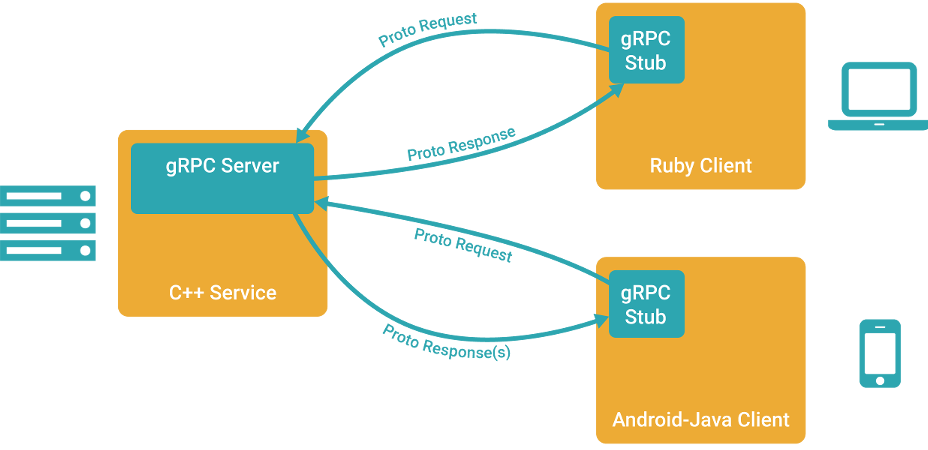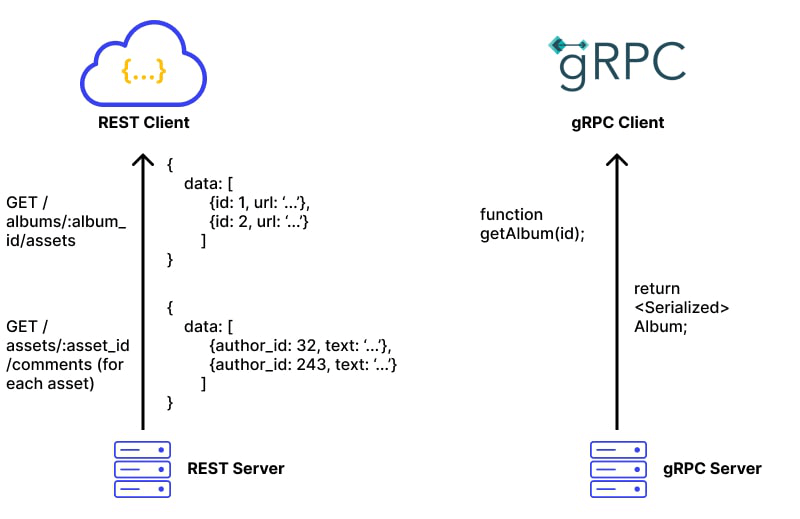Exploring gRPC: The Next Generation of Remote Procedure Calls
In the realm of distributed systems and microservices, effective communication between services is paramount. For many years, REST (Representational State Transfer) has been the dominant paradigm for building APIs. However, gRPC (gRPC Remote Procedure Calls) is emerging as a powerful alternative, offering several advantages over traditional REST APIs. In this blog, we’ll explore what gRPC is, how it works, and why it might be a better choice than REST for certain applications.
What is gRPC?
gRPC, originally developed by Google, is an open-source framework that enables high-performance remote procedure calls (RPC). It leverages HTTP/2 for transport, Protocol Buffers (Protobuf) as the interface definition language (IDL), and provides features like bi-directional streaming, authentication, and load balancing out-of-the-box.
 Source: gRPC
Source: gRPC
Key Components of gRPC
- Protocol Buffers (Protobuf): A language-neutral, platform-neutral, extensible mechanism for serializing structured data. It serves as both the IDL and the message format.
- HTTP/2: The transport protocol used by gRPC, which provides benefits like multiplexing, flow control, header compression, and low-latency communication.
- Stub: Generated client code that provides the same methods as the server, making remote calls appear as local method calls.
How gRPC Works
- Define the Service: Use Protobuf to define the service and its methods, along with the request and response message types.
- Generate Code: Use the Protobuf compiler to generate client and server code in your preferred programming languages.
- Implement the Service: Write the server-side logic to handle the defined methods.
- Call the Service: Use the generated client code to call the methods on the server as if they were local functions.
Example Protobuf Definition
syntax = "proto3";
service Greeter {
rpc SayHello (HelloRequest) returns (HelloReply);
}
message HelloRequest {
string name = 1;
}
message HelloReply {
string message = 1;
}
Why gRPC is Better Than REST
Performance
- HTTP/2 Benefits: gRPC uses HTTP/2, which supports multiplexing (multiple requests over a single connection), header compression, and server push, leading to more efficient use of network resources and lower latency compared to HTTP/1.1 used by REST.
- Binary Protocol: Protobuf is a binary format, making it more compact and faster to serialize/deserialize than JSON, which is text-based.
 Source: Refine
Source: Refine
Strongly Typed Contracts
- Protobuf IDL: The use of Protobuf enforces a strict contract between the client and server, reducing the chances of runtime errors due to type mismatches and ensuring that APIs are well-documented and versioned.
Bi-Directional Streaming
- Streaming Support: gRPC natively supports various types of streaming:
- Unary RPC: Single request, single response.
- Server Streaming RPC: Single request, multiple responses.
- Client Streaming RPC: Multiple requests, single response.
- Bi-Directional Streaming RPC: Multiple requests and responses, allowing for real-time, duplex communication.
Code Generation
- Automated Stub Generation: The Protobuf compiler generates client and server code, reducing boilerplate and ensuring consistency between client and server implementations. This accelerates development and minimizes human error.
Built-In Features
- Authentication and Security: gRPC supports authentication, load balancing, retries, and more out-of-the-box, providing robust tools for building secure and resilient services.
- Interoperability: gRPC supports multiple languages and platforms, making it easy to integrate with existing systems and ensuring broad compatibility.
Ecosystem and Tooling
- Rich Ecosystem: gRPC is supported by a wide range of tools and libraries, facilitating monitoring, debugging, and performance tuning. Tools like Envoy Proxy and Istio further enhance its capabilities in microservices environments.
When to Use gRPC
While gRPC offers many advantages, it may not be suitable for every use case. Here are some scenarios where gRPC shines:
- Low-Latency, High-Throughput Systems: Applications requiring high performance and efficient network utilization.
- Microservices: Complex systems with many inter-service communications benefit from gRPC’s efficiency and robust features.
- Real-Time Applications: Use cases needing bi-directional streaming, such as chat applications, real-time analytics, and IoT systems.
- Polyglot Environments: Systems built using multiple programming languages, leveraging gRPC’s cross-language support.
Conclusion
gRPC represents a significant evolution in API design and inter-service communication, offering numerous benefits over traditional REST APIs. Its performance advantages, strongly typed contracts, streaming capabilities, and rich ecosystem make it an excellent choice for modern distributed systems and microservices architectures. While REST remains a viable option for many applications, developers should consider gRPC when building performance-critical, scalable, and real-time systems.
By understanding the strengths and appropriate use cases for gRPC, you can make informed decisions about when to adopt this powerful technology in your own projects.